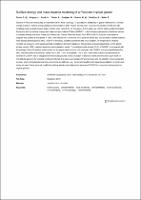Mostrar el registro sencillo del ítem
Surface energy and mass balance modeling of a Peruvian tropical glacier
| dc.contributor.author | Torres, C. | |
| dc.contributor.author | Arigony, J. | |
| dc.contributor.author | Arndt, A. | |
| dc.contributor.author | Tobias, S. | |
| dc.contributor.author | Gurgiser, W. | |
| dc.contributor.author | Suarez, Wilson | |
| dc.contributor.author | Santillan, N. | |
| dc.contributor.author | Maier, É. | |
| dc.date.accessioned | 2022-04-22T20:03:43Z | |
| dc.date.available | 2022-04-22T20:03:43Z | |
| dc.date.issued | 2019-12 | |
| dc.identifier.uri | https://hdl.handle.net/20.500.12542/1976 | |
| dc.description.abstract | Glaciers in Peruvian Andes play an important role for local hydrology. To quantify the availability of glacier meltwater in a climate change scenario, surface energy (SEB) and mass balance (MB) models are required. However, few studies of SEB and MB modeling using coupled process-based models were carried out for this region. In this study, we use the newly updated COupled Snowpack and Ice surface energy and mass balance model in PYthon (COSIPY) in its 2-dimesnional spatially distributed version to simulate energy and mass fluxes over Artesonraju Glacier, Peruvian Andes, from 2016 to 2018. A glacier mass balance program was started at this glacier in 1995, with installation of a network of 22 ablation stakes and two automatic weather stations were started operating since 2005. COSIPY is forced by weather parameters like solar radiation, air temperature, relativity humidity, air pressure, wind speed and total precipitation at hourly resolution. We generate meteorological fields on the glacier surface using a 1000 m spatial resolution digital elevation model. The surface height change (SHC) of COSIPY is compared with the average of the 22 ablation stakes drilled on the glacier ablation zone. We observed that COSIPY strongly overestimated the SHC, with simulated and observed values -23 m and -13 m, respectively. This is due to the surface albedo parameterization scheme of COSIPY, that is designed for mid-latitude glaciers and is a function of snowfall events and the snow layer depth. In mid-latitude glaciers, the snowfall events are intense, the snow layer remains for several days and the ablation occurs during the summer, while in tropical glaciers these conditions are different, e.g., the small snowfalls are frequents and ablation is continuous during all year. Future work will modify the surface albedo parameterization scheme of COSIPY to improve its performance for tropical glaciers. | es_PE |
| dc.format | application/pdf | es_PE |
| dc.language.iso | spa | es_PE |
| dc.publisher | American Geophysical Union | es_PE |
| dc.relation.uri | https://ui.adsabs.harvard.edu/abs/2019AGUFM.C13C1324T/abstract | es_PE |
| dc.rights | info:eu-repo/semantics/openAccess | es_PE |
| dc.rights | Atribución-NoComercial-SinDerivadas 3.0 Estados Unidos de América | * |
| dc.rights.uri | http://creativecommons.org/licenses/by-nc-nd/3.0/us/ | * |
| dc.source | Repositorio Institucional - SENAMHI | es_PE |
| dc.source | Servicio Nacional de Meteorología e Hidrología del Perú | es_PE |
| dc.subject | Glaciares | es_PE |
| dc.subject | Cambio Climático | es_PE |
| dc.subject | Glacier mass balance | es_PE |
| dc.title | Surface energy and mass balance modeling of a Peruvian tropical glacier | es_PE |
| dc.type | info:eu-repo/semantics/conferenceObject | es_PE |
| dc.subject.ocde | https://purl.org/pe-repo/ocde/ford#1.05.11 | es_PE |
| dc.subject.sinia | variabilidad climatica - Clima y Eventos Naturales | |
| dc.type.sinia | text/libro.presentacion | |
| dc.identifier.url | https://hdl.handle.net/20.500.12542/1976 |
Ficheros en el ítem
Este ítem aparece en la(s) siguiente(s) colección(es)
-
Congreso [32]









